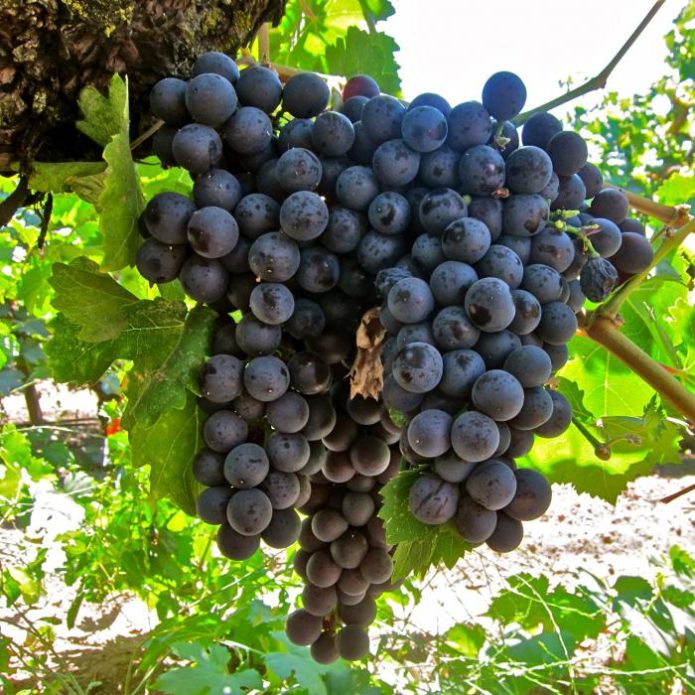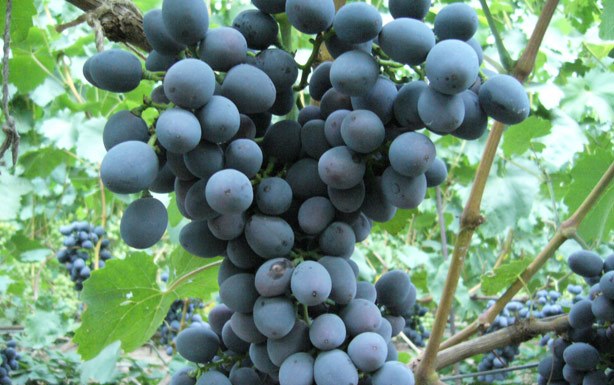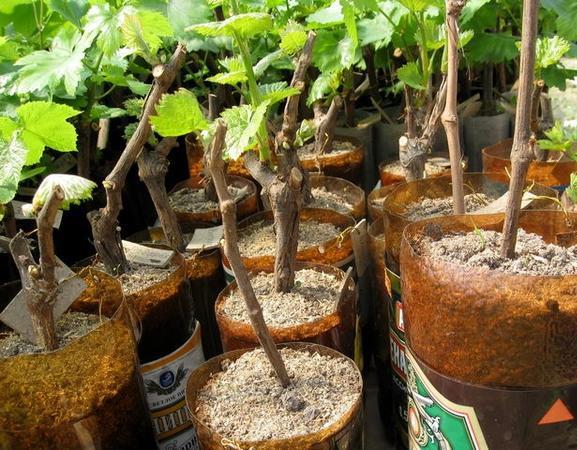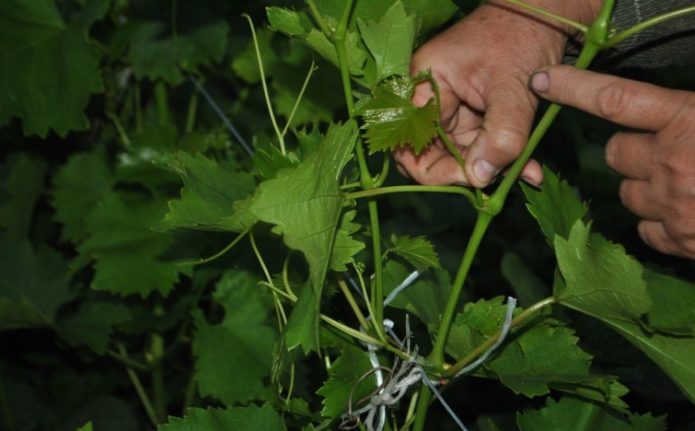The Sphinx grape is one table grape that hardly stands out for better or worse from the vast list of other modern varieties. The Sphinx is not bad because it is easy to grow, and therefore recommended for beginner vineyards. Its yield is high, the berries are tasty, but there are drawbacks, and significant ones.
Content
The history of the creation and description of the Sphinx grape variety
The Sphinx was bred at the beginning of the XXI century by an amateur breeder V.V. Zagorulko, who lives in Zaporozhye. The creator of the variety is not a professional agrarian, his specialty is a mechanical engineer, but his passion for youth led to the fact that he devoted his whole life to breeding new grape varieties, and a significant number of them became widely known.
The peculiarities of the breeder's interests are in the breeding of self-fertile table varieties that give tasty berries, well transported and having a good presentation. In this regard, the Sphinx does not quite fit into the overall strategy, and the author of the variety himself does not consider it very successful, noting certain significant shortcomings. The Sphinx was obtained by hybridization from the well-known strashensky and Timur varieties. Straseni is a Moldavian table grape variety intended for fresh consumption, fruiting with elegant and tasty dark berries. Early ripening grapes Timur is one of the frost-resistant white varieties.
The Sphinx obtained by crossing was born dark, high-yielding, fruiting at an early date. However, experts note that he inherited from his parents not only positive, but also negative aspects. At the same time, it is easy to care for and enjoys a certain popularity among novice winegrowers in the southern regions of Russia and even Belarus. It is also grown in other republics of the former USSR.
The Sphinx has large bushes that grow rapidly, and the vine ripens almost 100%. The leaves are also large. Frost resistance at -23 aboutC, the variety also tolerates very hot weather. It is afraid of drafts, which distinguishes it not for the better and requires careful selection of a place for planting. Resistance to major grape diseases is average; mandatory preventive spraying against mildew and oidium is required.
Video: Sphinx bushes at the time of the harvest
The flowers and the Sphinx are bisexual, which allows you to do without planting other varieties for pollination and is one of the advantages, especially for summer residents with small areas. Flowers bloom late, the danger of freezing during the return frosts in May is minimal. The variety is considered early, but the specific timing of the readiness of the crop strongly depends on the climate of the region and the current weather; usually full ripening of berries falls on the second ten days or the end of August.
The bunches have a shape close to conical, their usual weight is a little less than a kilogram, the record holders reach 1.5 kg. The berries are not very beautiful.They can be perfectly round or slightly oval, relatively large, weighing up to 10 g, dark blue. A huge drawback is that the ripening is stretched, and ripe bunches must be plucked immediately: they are not stored on the bushes, they wither and become unusable. The skin is firm, crunchy when bitten. The pulp is juicy, dense, with the usual grape flavor. Experts talk about the peculiar aroma of the berries, felt when they are eaten.
In good seasons, sugar accumulation is high: up to 25%, but in cold years it can stop at 17%. The total acidity does not exceed 6 g / l. A versatile variety, but mainly used for eating fresh berries.
Features of planting grapes and caring for them
In terms of planting and growing rules, the Sphinx is not much different from most grape varieties. This is a common early grape, requiring shelter for the winter. It is even somewhat easier to care for it than for many other varieties. The rooting rate of the Sphinx is very high, so the seedling can be grown on its own, acquiring lignified cuttings somewhere.
When planting with a cuttings or seedlings, one must remember about the peculiarity of the variety, which prohibits planting it in wind-blown areas. The Sphinx is so afraid of drafts that it is often even used for greenhouse cultivation. However, mostly grapes are planted, nevertheless, in the open field, and here you have to try to choose a place. It is advisable not only to plant it against the wall that protects from the northern winds, but also to plant tall bushes or fruit trees on the western and eastern sides. As a last resort, build artificial wind barriers. In this regard, although the frost resistance of the Sphinx is high, we have to admit that it is more suitable for cultivation in the southern regions. The Sphinx is capable of growing on any soil, but the best option is light and breathable.
When choosing a place, one must take into account that in the second year it will grow into a rather large bush and even give the first harvest.
It is better to plant grapes in April, but in the south you can also in October. Planting is usual, as for other varieties: in the fall, a plot is dug up and a large planting pit is being prepared. At the bottom, it is imperative to place a drainage from gravel in a layer 15–20 cm thick, especially on clay soils. Above is a layer of well-fertilized soil, and there should be no fertilizer in the root zone of the seedling. It is advisable to run the irrigation pipe to the very bottom of the pit.
If more than one bush is planted, the distance between them should be about 2 meters. When planting in April, only one or two buds are brought to the surface, the seedling is well watered and the soil is mulched.
Care is simple: periodic watering (especially during the filling of berries and before winter), fertilizing with organic and mineral fertilizers, preventive spraying, careful pruning. As a fertilizer, ordinary wood ash is very good, and foliar feeding is useful during the growing season. They are performed by spraying the leaves with weak solutions of complex fertilizers. Spraying as a prophylaxis of diseases is carried out in early spring (with iron vitriol) and at the beginning of the growing season (with Ridomil gold).
Pruning can also be done in spring, but only before the buds begin to swell. In the summer, excess shoots and stepchildren are removed while they are still green, and in the fall, immediately in front of the winter shelter, they carefully cut out the excess that was not noticed in the summer. The vines are cut, leaving 4-6 eyes on the shoots.
Shelter of the Sphinx for the winter is mandatory, except in the southern regions. It is not necessary to bury the grapes in the ground, it is enough to spread the vines on the ground and tie them in bunches, cover them with spruce branches or non-woven materials. The main thing is that there are no severe frosts before a sufficient amount of snow falls.In the spring it may seem like the shoots are frozen, but this can be a misleading impression. The Sphinx does not wake up very early, but, having begun the growing season, it blooms and grows very quickly.
Video: Sphinx grape harvest on the bushes
Advantages and disadvantages of Sphinx grapes
Among the early grape varieties, the Sphinx is not the best and in many respects is inferior to such famous varieties as, for example, Arcadia, Livia or Victor. But he is very unpretentious in care, which is very valuable. Its main advantages are:
- early entry into fruiting;
- good productivity;
- lack of peas (berries in bunches are aligned);
- decent berry taste;
- sufficient frost resistance;
- resistance to spring frosts;
- ease of care.
The list of shortcomings is also not very small, and the main ones are recognized:
- low-market type of bunches;
- spoilage of berries in rainy weather;
- poor safety of berries not picked in time;
- not very good transportability;
- not very high resistance to the most dangerous diseases;
- high degree of destruction of berries by wasps.
Thus, the Sphinx is not very suitable for planting in commercial farms, but as a variety for summer cottages, especially for novice gardeners, it is quite suitable.
Gardeners reviews
Personally, I did not like its taste, Codryanka ripens not much later, but takes with its yield (up to 50 kg per bush) and surpasses it in taste, so I said goodbye to the Sphinx this year.
The Sphinx is one of the few forms of Zagorulko that does not create problems. It hurts a little, does not crack, hangs for a long time, does not rot. The size of the berry is certainly not gigantic, but quite worthy for its duration.
Since we are talking about the Sphinx, then I liked the shape ... Grafted on Kober. First fruiting. I threw out 2 huge inflorescences for the shoot. Not affected by spring frosts. Bloomed together and at the same time. And the next day I got caught in a downpour with the wind. Pollination is therefore at "3", but now it has begun to color and due to the size of the berries the clusters look good. Something reminded in this respect Denal. A young Richelieu bush grows nearby, so they follow the color and set of sugar "head to head." In any case, they are far ahead of the Viking.
GF Sphinx looks good. The form is grafted on the Gift to Zaporozhye, has been bearing fruit for four years. Vigorous, the vine ripens perfectly, with good resistance to diseases and temperatures. If many forms in the last season barely moved away after frosts, the Sphinx gave a decent harvest. The bunches were up to 1 kg, ripened in the Kuban around August 5–8 - not bad: we have few black varieties at this time. We really liked the taste of the berries: without any aftertaste, but pleasantly refreshing. The pulp is dense, juicy, with a crunch. The berries hung for two weeks after full ripening, they did not lose either taste or presentation. I didn't have enough patience for more - they ate it. Wasps have not been seen near the bunches of the Sphinx. When growing bushes of GF Sphinx, I like the fact that there are almost no stepchildren's clusters on it and the vine ripens very early to the very tips.
The early Sphinx grape is a table variety successfully cultivated in private gardens due to its undemanding growing conditions, yield and good berry taste. However, the unpresentable appearance of the bunches does not make it possible to recommend the variety for sale for large farms. The Sphinx is one of the ideal varieties for the novice grower.






